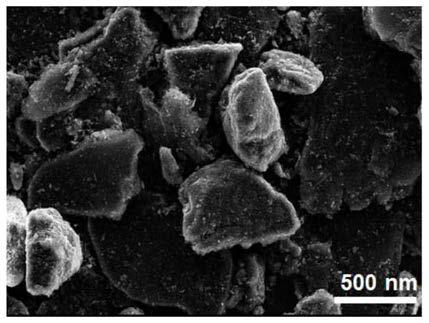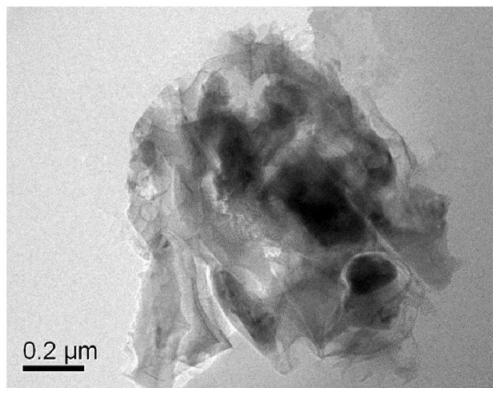High-capacity lithium ion battery negative electrode material capable of being industrially produced
A lithium-ion battery and negative electrode material technology, applied in the direction of battery electrodes, negative electrodes, secondary batteries, etc., can solve the problems of unsatisfactory cycle stability, rate performance and safety performance, and achieve high capacity and good cycle performance. Uniformity, avoiding the effect of high energy consumption
- Summary
- Abstract
- Description
- Claims
- Application Information
AI Technical Summary
Problems solved by technology
Method used
Image
Examples
Embodiment 1
[0046] A method for preparing an industrially produced high-capacity lithium-ion battery negative electrode material, comprising the following steps:
[0047] (1) After washing and drying micron-sized industrial silicon powder with HCl, it is crushed by a crusher, and then classified on a jet mill equipped with an air cyclone to obtain 2-3 µm precursor silicon powder;
[0048] (2) Place the precursor silicon powder in step (1) in a calciner, raise the temperature to 950°C, and feed a mixed gas containing water vapor, oxygen and argon, with a water vapor content of 8% and an oxygen content of 2%. Calcining for 6 hours to prepare a composite powder of silicon oxide and silicon;
[0049] (3) Mix the prepared composite powder of silicon oxide and silicon with the artificial graphite matrix material in a mass ratio of 1:1 through a mechanical fusion machine for 3 hours to obtain a mixture powder;
[0050] (4) Next, put the powder in step (3) and coal-based medium-temperature pitch...
Embodiment 2
[0058] A method for preparing an industrially produced high-capacity lithium-ion battery negative electrode material, comprising the following steps:
[0059] (1) After washing and drying micron-sized industrial silicon powder with HCl, it is crushed by a crusher, and then classified on a jet mill equipped with an air cyclone to obtain 2-3 µm precursor silicon powder;
[0060] (2) Put the silicon powder precursor in a calcination furnace, raise the temperature to 950°C, pass in a mixed gas containing oxygen and nitrogen, the oxygen content is 20%, and calcine for 10 hours to prepare a composite powder of silicon oxide and silicon;
[0061] (3) Mix the prepared composite powder of silicon oxide and silicon with the artificial graphite matrix material in a mass ratio of 1:1 through a mechanical fusion machine for 3 hours to obtain a mixture powder
[0062] (4) Next, put the powder in step (3) and coal-based medium-temperature pitch with a median particle size of 15-30 μm in a VC...
Embodiment 3
[0069] A method for preparing an industrially produced high-capacity lithium-ion battery negative electrode material, comprising the following steps:
[0070] (1) After washing and drying micron-sized industrial silicon powder with HCl, it is crushed by a crusher, and then classified on a jet mill equipped with an air cyclone to obtain 2-3 µm precursor silicon powder;
[0071] (2) Put the silicon powder precursor in a calcination furnace, raise the temperature to 800°C, pass in a mixed gas containing water vapor and argon, with a water vapor content of 15%, and calcine it in an atmosphere containing an oxidizing atmosphere for 10 hours to prepare Obtain the composite powder of silicon oxide and silicon;
[0072] (3) Mix the prepared composite powder of silicon oxide and silicon with the artificial graphite matrix material in a mass ratio of 1:1 through a mechanical fusion machine for 3 hours to obtain a mixture powder;
[0073] (4) Next, put the powder in step (3) and the phe...
PUM
| Property | Measurement | Unit |
|---|---|---|
| Particle size | aaaaa | aaaaa |
| D50 | aaaaa | aaaaa |
Abstract
Description
Claims
Application Information
 Login to View More
Login to View More - R&D
- Intellectual Property
- Life Sciences
- Materials
- Tech Scout
- Unparalleled Data Quality
- Higher Quality Content
- 60% Fewer Hallucinations
Browse by: Latest US Patents, China's latest patents, Technical Efficacy Thesaurus, Application Domain, Technology Topic, Popular Technical Reports.
© 2025 PatSnap. All rights reserved.Legal|Privacy policy|Modern Slavery Act Transparency Statement|Sitemap|About US| Contact US: help@patsnap.com



